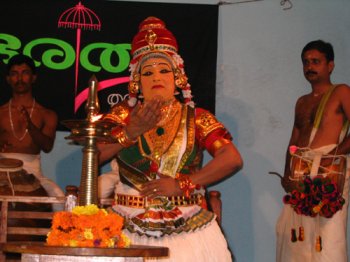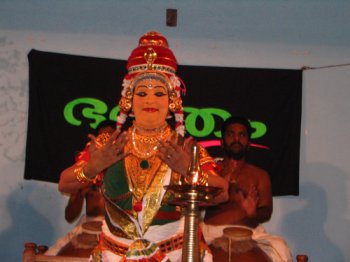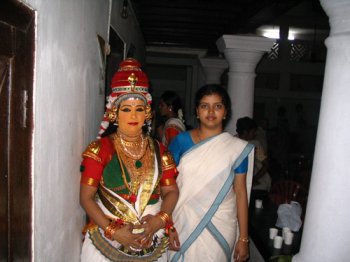
 Seethayanam
in Nangyarkoothu Seethayanam
in Nangyarkoothu
- Padma Jayaraj,
Thrissur
e-mail: padmajayaraj@gmail.com
Photos: Raghavan
Sahasranaman
August 26,
2008
The Malayalam
month of Karkidakam is the month of Ramayana in Kerala. An agrarian
community found leisure when the monsoon rains meditated over its land.
In feudal Kerala, the day in Karkidakam began with the head of the
family reading a portion of Ramayana under the light from a bell-metal
lamp. With the break up of joint family, this ritual confined itself to
temples and cultural events. Bharatam, a club that promotes culture, premiered
SEETHAYANAM, in Thrissur. A three-day programme in traditional format of
Nangyarkoothu by Margi Sati is an innovative effort.
Koodiyattam
is the oldest Sanskrit drama preserved by the community of Chakyars and
Nambiars as part of ritual performance in Kerala. It was Painkulam Rama
Chakyar who brought it out of temple precincts. Poet Vallathol who founded
Kalamandalam made it a subject of study. UNESCO recognized it as
the intangible tradition of mankind. Koodiyattam artistes like Margi Sati
and Usha Nangyar concentrate on Nangyarkoothu, the female centred part
of Koodiyattam. As heads of faculties, they are doing a lot to enrich this
classical art. Nangyarkoothu is a solo show by a woman performer for which
extant texts are limited.
Margi Sati
emerged as a ground-breaking artiste with her interpretation of Sree
Rama Charitam and Kannagi Charitam.
 Changing
times have brought new perceptions and philosophies to the fore in Kerala.
The story line of Seethayanam is true to the original. Yet the choreography
focuses on a modern interpretation of the familiar story. Another inventive
effort is to introduce a simultaneous verbal rendering of the visual sign
language so that ordinary people follow each and every nuance. And serious
viewers get a chance to learn the grammar of the sign language specific
to Koodiyattam. Like Painkulam Rama Chakyar, Margi Sati tries at democratisation
of an elite art form. Changing
times have brought new perceptions and philosophies to the fore in Kerala.
The story line of Seethayanam is true to the original. Yet the choreography
focuses on a modern interpretation of the familiar story. Another inventive
effort is to introduce a simultaneous verbal rendering of the visual sign
language so that ordinary people follow each and every nuance. And serious
viewers get a chance to learn the grammar of the sign language specific
to Koodiyattam. Like Painkulam Rama Chakyar, Margi Sati tries at democratisation
of an elite art form.
Seethayanam
focuses on three chapters of Seetha's life that defines her persona and
paints her growth from an innocent maiden to a matured woman and a mellowed
noble lady who acquires an iconic status. Seetha is the quintessence of
the feminine, fallible but strong and dignified.
Seetha
in Panchavati is a beautiful presentation of girlish charm and childlike
simplicity. Away from the palace, perhaps for the first time in her life,
she explores the beauty of the wild. Flowers burdened with honey, twittering
birds, water-falls and rushing streams exhilarate her. Each is a thing
of beauty, an object of wonder. Surprise and curiosity lead her to flora
and fauna. It is as if Seetha herself had become a gentle being of the
forest. Suddenly she spots a woman, a beauty. She sees her talking to Rama.
And she hears Rama telling her that his wife is with him and asking her
to seek Lakshman. Seetha wonders why Rama tells a strange woman to go to
Lakshman. After all, Lakshman too is a married man, married to her own
sister. It is just a fleeting thought.
Distracted
by striking flowers, the girl bends down to pick them up to make a garland.
Soon Rama joins her. Seetha gifts him the garland of flowers which in turn
adorns her hair. An exquisite love scene with all lyrical charm is superbly
executed. Now, Seetha is drawn to a deer nearby, nibbling grass. She tries
to feed it; wants to hold it. But then, it trots away in all playfulness.
She requests Rama to bring it for her. And Rama goes after it. The
inevitable happens. The cries of Rama rent the air, a disturbed Seetha
asks Lakshman to go in search of her husband. And Lakshman, who knows the
strength of his brother, tells her that his duty is to safeguard her, a
woman. Seetha says that a woman is saved not by a man but by her intrinsic
strength. She does not hesitate to tell him that he cannot harbour any
evil design as she would not live without her husband. The troubled Lakshman
goes out; Seetha sits immersed in thoughts. She is alerted by the presence
of a sage near the ashram. With all nobility, Seetha invites him and promises
to serve him with things needed for his pooja and goes inside.
 The
second day presents Seetha in Ashokavanam, in Lankapuri. Her encounter
with Ravan and Hanuman later in the scene juxtaposes two aspects of her
character. The Seetha we see here is grief stricken: she is thoughtful,
regretting her past actions. The technique of flashback is used to describe
her abduction by Ravana, and meeting Jatayu who fights to save her. A resourceful
Seetha has discarded her jewels on the way to lead Rama through the trail.
She regrets how thoughtlessly she had blamed Lakshman. How gullible she
had been not to sense the trap. Yet she wonders why Rama did not check
her whims and fancies. Although Seetha has matured at one stroke, her innate
love of nature is irrepressible. She is surprised by the beautiful garden.
It is a contrast to the wild Panchavati. This is a cultivated grove with
rare trees full of scented flowers as if they were heaven sent. Wonder
overwhelms her. She picks up a flower to enjoy its exciting scent. But
suddenly she feels it is not hers, but her enemy's. She is imprisoned in
this garden. Sure enough, there comes Ravan, lovelorn, eager for her. She
becomes alert and withdrawn, ready to fight in her own way. The
second day presents Seetha in Ashokavanam, in Lankapuri. Her encounter
with Ravan and Hanuman later in the scene juxtaposes two aspects of her
character. The Seetha we see here is grief stricken: she is thoughtful,
regretting her past actions. The technique of flashback is used to describe
her abduction by Ravana, and meeting Jatayu who fights to save her. A resourceful
Seetha has discarded her jewels on the way to lead Rama through the trail.
She regrets how thoughtlessly she had blamed Lakshman. How gullible she
had been not to sense the trap. Yet she wonders why Rama did not check
her whims and fancies. Although Seetha has matured at one stroke, her innate
love of nature is irrepressible. She is surprised by the beautiful garden.
It is a contrast to the wild Panchavati. This is a cultivated grove with
rare trees full of scented flowers as if they were heaven sent. Wonder
overwhelms her. She picks up a flower to enjoy its exciting scent. But
suddenly she feels it is not hers, but her enemy's. She is imprisoned in
this garden. Sure enough, there comes Ravan, lovelorn, eager for her. She
becomes alert and withdrawn, ready to fight in her own way.
Ravan is conscious
of the superiority of his physique, of his material wealth. He is willing
to offer anything to make her his own. Seetha plucks a grass and speaks
to it. It is a sign of her nobility as well as her courage to dare a devil.
Ravan adopts a softer tact. He prostrates before her. But Seetha has only
contempt and revulsion for such an act. Defeated, Raven withdraws crestfallen.
It is admirable
to see that fear does not cross Seetha's mind. She is conscious of her
superior inherent strength. Soon she hears Rama's name, repeated with devotion.
Trapped once, Seetha could not believe what she hears. The mighty Hanuman
jumps down from a tree. And in girlish innocence Seetha is frightened of
the huge monkey. He prostrates at her feet. Intuitively she blesses him.
What a contrast to Ravan's gesture of prostrating at her feet and her reaction!
It is a tender scene in which Hanuman gains her confidence. She recognizes
Rama's signature ring. Hanuman whispers something, a verbal sign. The rejuvenated
Seetha recalls a warm scene of their happy days when the verbal sign was
made. And it sets the mood of trust and friendship that is to last for
the rest of their lives despite tragic events. Seetha watches a retreating
Hanuman filled with hopes…
 Abandoned
on the banks of River Thamsa: On the final day, the story from Uthara
Ramayana was staged. The scene begins with Seetha plucking flowers
for pooja. Her thoughts take her back to the day her trusted brother Lakshman
brought her to the river bank just to abandon her. It was sage Valmiki,
who took her to his ashram and gave her shelter. It was here her twin sons
were born. Seetha could never decipher her rejection by Rama. Can it ever
be justified after the so called Agni- pariksha, trial by fire?
And how could Rama, who had brought Ahalya back to life after her trespass,
abandon his own wife whose purity was declared before public gaze? All
along these years she has swayed between hopes and fears. Knowing the truth
as a husband, Rama has to come. But a fear lurked that such a thing need
not happen because Rama is a king. And there is really no such need after
all these years. Abandoned
on the banks of River Thamsa: On the final day, the story from Uthara
Ramayana was staged. The scene begins with Seetha plucking flowers
for pooja. Her thoughts take her back to the day her trusted brother Lakshman
brought her to the river bank just to abandon her. It was sage Valmiki,
who took her to his ashram and gave her shelter. It was here her twin sons
were born. Seetha could never decipher her rejection by Rama. Can it ever
be justified after the so called Agni- pariksha, trial by fire?
And how could Rama, who had brought Ahalya back to life after her trespass,
abandon his own wife whose purity was declared before public gaze? All
along these years she has swayed between hopes and fears. Knowing the truth
as a husband, Rama has to come. But a fear lurked that such a thing need
not happen because Rama is a king. And there is really no such need after
all these years.
Sage Valmiki
has undertaken the mission of educating her sons. The sage has taken them
to the palace of their father, the king. There they will sing their story.
Her imagination conjures up how a surprised Lakshman recognizes them. Rama
may not display his emotions publicly.
Again she
wonders whether there will be a reunion! Perhaps another trial by fire!
And what is the point? Does it matter now? Her foster father, King Janaka
took her from the lap of Mother Earth. She has found succour and solace
only in Nature. And there is her final resting place, Mother Earth. Seetha
is like a hermit now, all her desires vanished, with no regrets and no
hopes. Calm of mind, accepting life as an experience, Seetha sits in a
meditative poise waiting for the final exit.
The presentation
of the performance retains its hallowed traditional format. The sound of
the conch as twilight deepens is the curtain raiser. The bell-metal lamp
with its three wicks: one turned towards the audience, two towards the
performer is part of the salutation.
The percussive
support (on mizhavu, the drum exclusive to Koodiyattam, by
Ramanunni and Sajikumar, thimila Mohanan and Edakka Sudeesh,
all Kalamandalam artistes except Edakka by Krishnaraj, thalam, singing
and verbal rendering by Rangasree, Revathy) gives the perfect musical backdrop
evoking temple association. And the quality of the music creates the right
mood in a traditional rhythmic sphere. Simultaneous verbal rendering of
choreography correlates stylisation with realism. Visual imageries and
emotions are conveyed in fluid movements. The enactment of the male and
female roles, evocative music, thought process and expression of emotions
remain in perfect alignment.
Seetha looms
large as a part of the backdrop of Nature. Nature reflects her moods and
thoughts, preparing for her final exit. We read the growth of Seetha's
mind from the feminine to the feminist. The change in her attitude is hinted
at the very first scene itself when she wonders why Rama should send Soorpanakha
to Lakshman. Fidelity in matrimony is a modern concept introduced. This
perception sets the tone and tenor of Seethayanam. The character
of Seetha is portrayed with grace and charm, with dignity and restraint,
evocative and profound especially where her thoughts border on a feministic
stance. Yet, the finale is the supreme spiritual grandeur native to Indian
philosophy that has made Seetha an icon in Indian imagination.
Padma
Jayaraj is a freelance journalist and a regular contributor to www.narthaki.com |

